

NORMAN CLARK A LIFE IN PICTURES
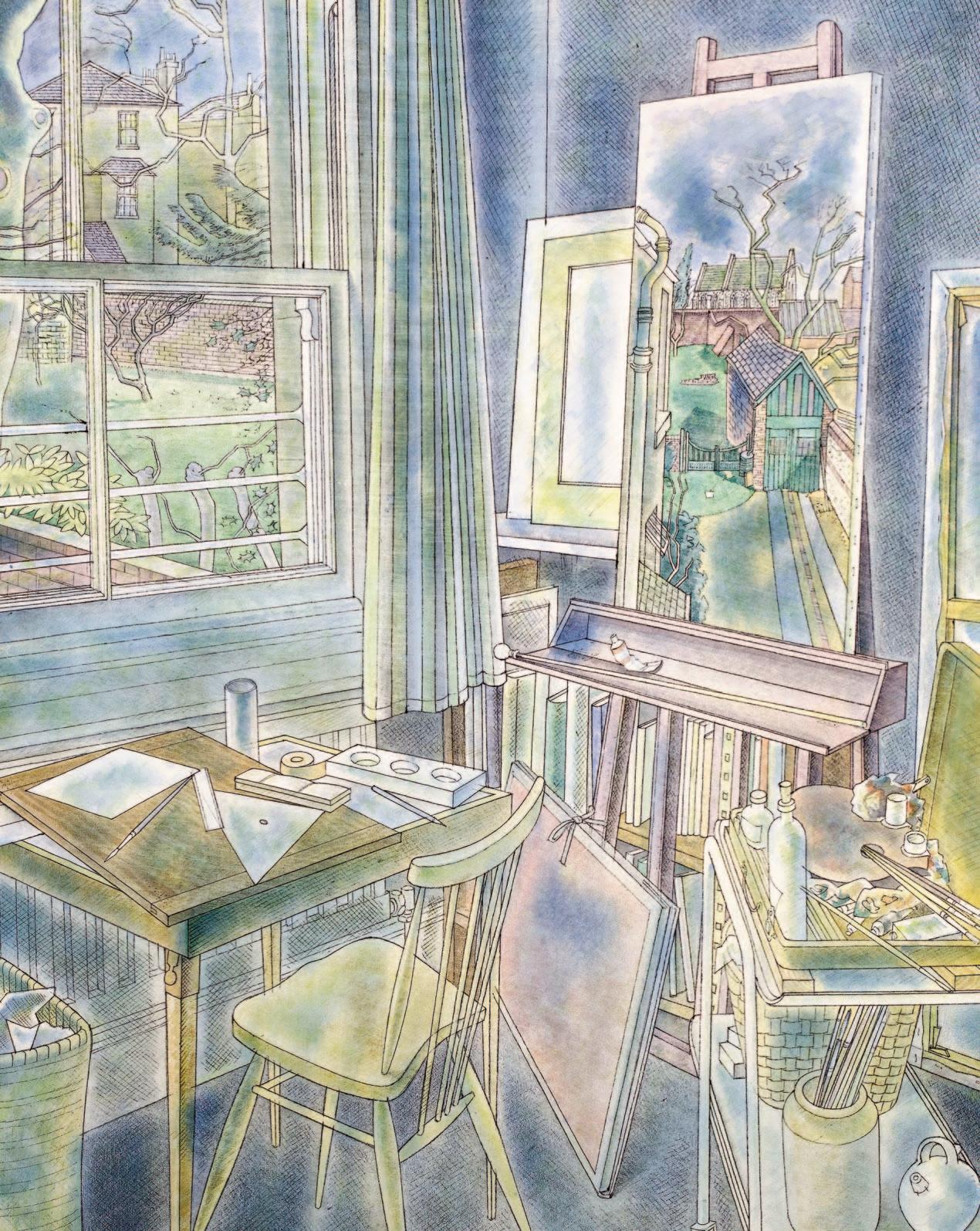
Front cover: The Oak Tree at Applegarth [cat. 23]
Rear cover: Still Life with a Copy of the Listener [cat. 19]
Opposite page: The Studio, Mountfield [cat. 31]
NORMAN CLARK A LIFE IN PICTURES
Paintings and Works on Paper by Norman Clark, RWS (1913-1992)
With an introductory essay by David
Boyd-Haycock
6 Mason’s Yard, Duke Street, St James’s, London SW1Y 6BU
30th May – 13th June 2024
HARRY MOORE-GWYN
BRITISH ART
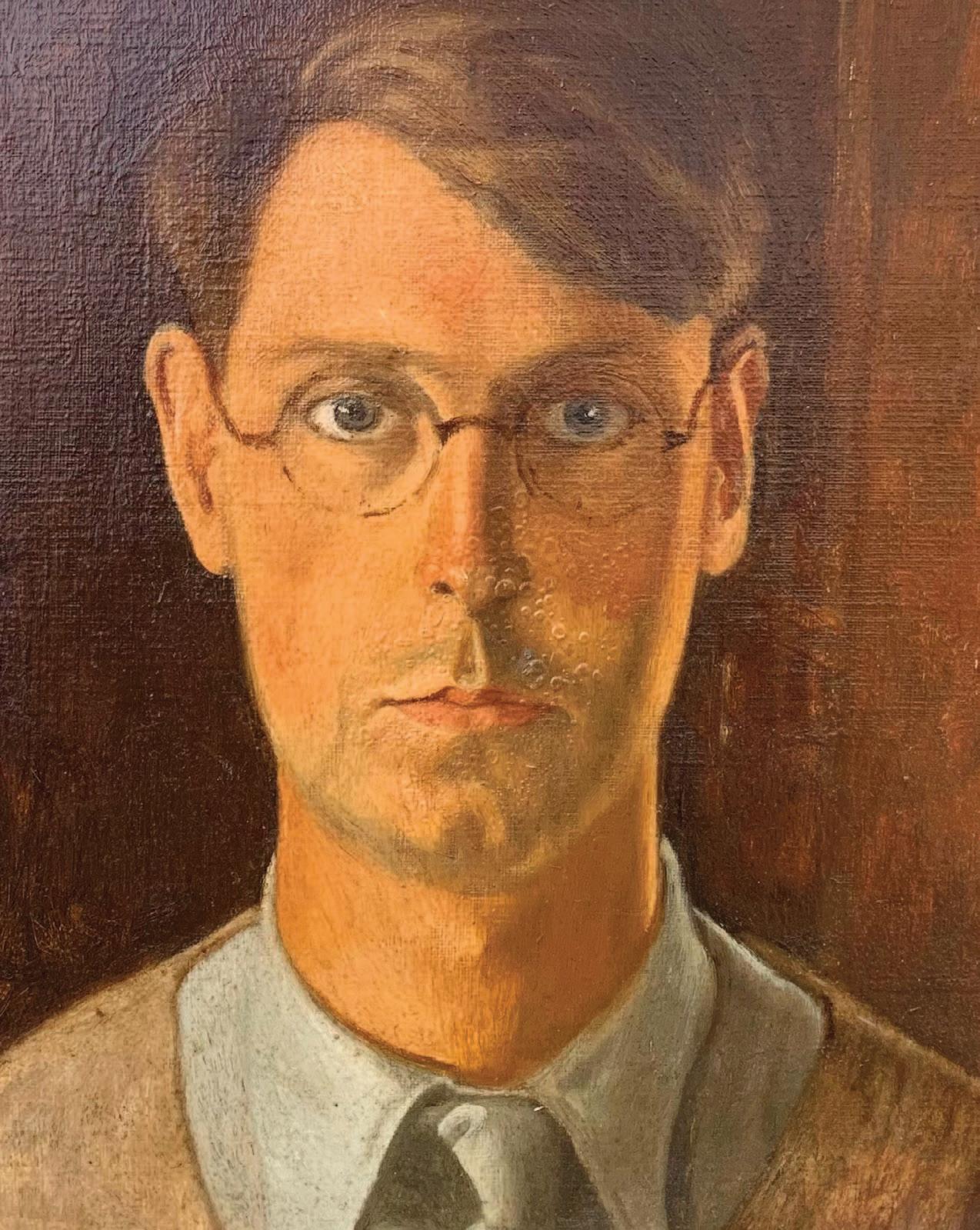
Foreword
This is the first retrospective exhibition of the work of Norman Clark outside of his native county of Sussex. It is also the first substantial catalogue to pay tribute to this highly individual and engaging painter once described by his tutor at the Royal Academy Schools, Thomas Monnington (later president of the Royal Academy) as “certainly one of the most interesting students at the Royal Academy schools in the two years I have been teaching there.” Certainly, the catalogue of prizes awarded to him as a student there bear witness to this and yet for the most part Clark eschewed the pursuit and fame of the full-time painter for the role of the teacher –inspiring generations of students at Brighton College of Art (and later Brighton Polytechnic).
The majority of the works in the present catalogue come directly from the artist’s studio and many are being shown in public for the first time. We are hugely grateful to the artist’s daughter
Penny Hopkins for her time and support with this project as well as to David Boyd-Haycock for the introduction to the catalogue, which has, for the first time, succeeded rightly in placing Clark in context in the history of figurative British art of the mid twentieth century.
Harry Moore-Gwyn
Self Portrait, c.1930, oil on canvas (collection of the artist’s family)
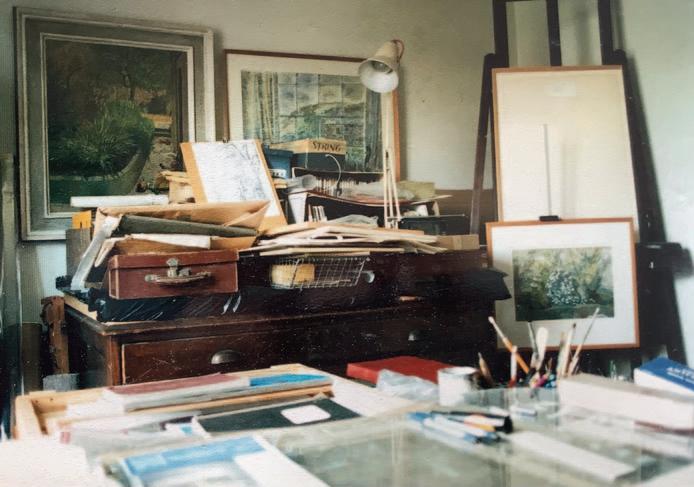


The artist as a young boy
Norman Clark: A Life in Pictu
res
There’s something about the very beginning of an artist’s career that I find fascinating. It’s why my art historical investigations have always started as early in my subject’s life as possible. What were the first images that inspired them? How and why did they come to art as something that would preoccupy them – often for the rest of their life? Where did that early interest lead them, and how did they make it their own? And how much of that early inspiration to create can still be observed in the character and subject matter of their mature work?

Chopping Wood, c.1932, watercolour (collection of the artist's family)
These same questions crossed Norman Clark’s mind. In 1989, when he was nearing the end of his life (he died in 1992, aged almost eighty), he wrote a brief biographical statement. ‘As a schoolboy,’ he began, ‘I admired the illustrations of the “Boys Own Paper,” particularly I remember the black and white drawings of the brothers Henry Matthew and Charles Edmund Brock.’ The various unnamed draughtsmen who illustrated another classic English weekly magazine of the era also impressed him: in Punch he admired ‘the way the scenes of contemporary life were so skillfully and economically rendered in terms of black ink lines in varying degrees of density and direction on the white paper in such a manner as to suggest light and tonal values.’ And he loved Herbert Railton’s black and white drawings ‘of ancient crumbling buildings’ that he saw in his grandmother’s old bound volumes of the Illustrated London News. ‘It seemed to me that the life of such an artist must have been one of great contentment,’ he reflected, ‘and thought at the time that such an activity was pretty well all that Art was about.’
These black and white pen illustrations, together with their lithographic colour companions, were the visual bread and butter of the pre-television era in which Clark grew up. There is something endearing, imagining the young boy leafing through old back-issues of the ILN, entranced by the pictures. They were images that often told – very often accompanied – a story. And we do see the influence of this early interest in Clark’s mature work: they are paintings of people, and places: of men in war but not at war; of gardens seen from attic windows; the overlooked detail of rooftops; a vicar with a yo-yo, and everyday town and country folk going about their business. All of them are
seen by an artist who has been trained to look, but one who also finds clear enjoyment in the ordinary and the everyday, and yet who manages to raise it above the ordinary.
In this respect, Clark is akin to a number of other British artists from this same period.
One thinks particularly of the men and
women who, in the years before the Second World War, congregated around Edward Bawden and Eric Ravilious in the Essex village of Great Bardfield. They included John Aldridge, Barnett Freedman, Tirzah Ravilious, Michael Rothenstein and Kenneth Rowntree (the latter the subject of a previous exhibition curated by Harry Moore-Gwyn).
Coincidentally, Norman Clark, like Bawden, came from Essex. He was born in Ilford in 1913, a decade after Bawden. Though younger than the Great Bardfield artists, the First World War and its aftermath likewise shaped him: it was deeply imbedded in the cultural psyche of the nation. In 1989 Clark could still remember being taken to the Crystal Palace by his father in the early 1920s, when it was
the first home of the Imperial War Museum. It was filled with the weapons and paintings of war. Though Clark remembered being ‘greatly moved’ by John Singer Sargent’s Gassed, it was ‘the jagged works of the Vorticists’ that later struck him ‘as being more vividly expressive of the horror and futility of war. At the same time, the paintings of the Nash brothers, Paul and John, seemed to display a poetical quality.’

The strong impression created on him by the Vorticist war paintings is, perhaps, surprising. This was the movement launched by Percy Wyndham Lewis in London in the summer of 1914, and characterized by the lurid pink jacket of the anarchic magazine/manifesto, BLAST. There is little obvious modernism in Clark’s oeuvre; yet there is something of the poetic quality of the Nash siblings’ pre- and post-war work. Clark is more like Paul’s younger brother, John: it is a more conservative love not just of nature, but of the particular and the everyday.
fig.1
Harvest Fantasy, 1933, oil on board laid to card [cat. 05]
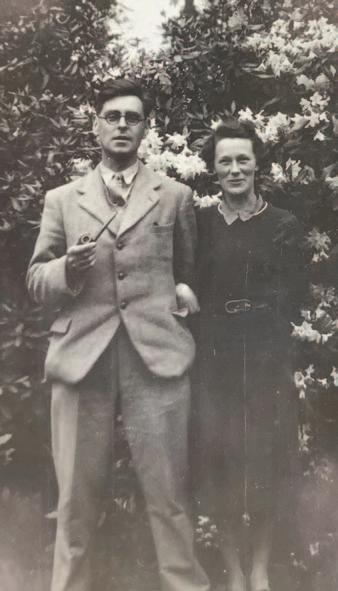
That said, there is something of the Surreal to be seen in Clark’s rather mysterious 1933 landscape, Harvest Fantasy ( fig.1). And he
seems to hint a little at the influence of the unconscious upon him when he writes of his work at the very end of his 1989 statement:
The almost always invented environments for these compositions of figures contain objects which may have some significance, although it is impossible for me fully to comprehend their meaning. It is perhaps sufficient to say that these images insist on being given form, and that I am aware that the visual language employed is for the most part learned from ‘the pictures in the museum.’
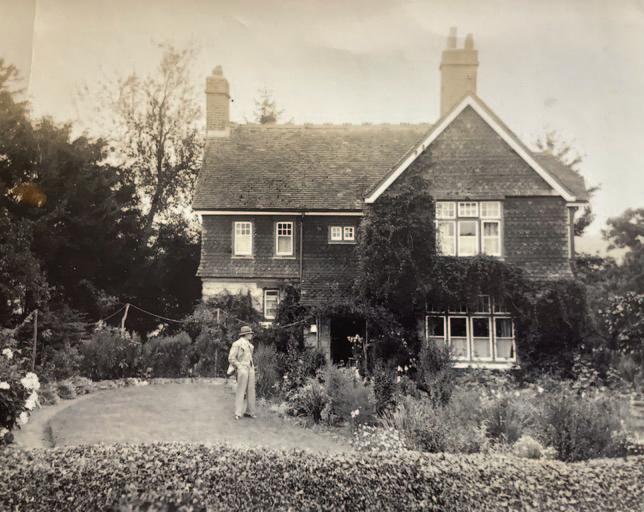
Clark would never make the full transition to
Neo-Romanticism that this one painting hints at. It was a path untaken. Perhaps, like the toxic effect of the Great War on John Nash, he soon reacted against the ominous undercurrents of Modernism.
Harvest Fantasy was painted when Clark was still a student at the Royal Academy School of Painting. He had arrived there in 1930, aged seventeen, after an enjoyable year spent at the
Central School of Arts and Crafts in London.
This financially necessary but reluctant move, he wrote in 1989, ‘seemed, at first, like stepping back from the modern world into the eighteenth century, but I was soon to discover that the teaching offered at the time was basically of Slade origin.’ The Royal Academy School’s Keeper, Walter W. Russell, RA (later Sir Walter) had taught at the Slade alongside Henry Tonks and Philip Wilson Steer between 1895 and
1927. More of the Slade atmosphere was added in 1931 when Walter Thomas Monnington (later to become President of the RA) arrived as assistant to the Keeper. ‘He’d been a distinguished teacher at the Slade,’ Clark recalled, and his mural work was well known and admired ‘both by myself and other students at the RA. I am afraid we secretly respected him far more than we were prepared to own, possibly because of his apparent youth.’ (He was only 29 at the time of his arrival, and was married to another former Slade student and British School at Rome scholar, Winifred Knights.)
Clark remained at the Royal Academy Schools until 1935. He proved a talented, prizewinning student, willing to learn from those around him. Walter Bayes, who had been a member of the Camden Town Group, gave evening lectures in perspective, whilst other visiting artists included Charles Ricketts and
Gerald Kelly. As Clark recalled, the latter’s ‘personal anecdotes of his former acquaintanceships with Degas, Cézanne, Monet, Pissarro and Sisley seemed at first strangely at odds with his academic and no-nonsense attitude towards the study of Painting, which had Still Life, studied by the time values, as its basis. His description of the methods of Walter Sickert, also taken at first hand, were most interesting.’
Though the names Russell, Monnington, Kelly and Bayes are less familiar today, they were important artists for a young student to be rubbing shoulders with: men of experience, shrewdly imparting their knowledge. As Clark explained in his memoir, you could walk to
the Tate Gallery or to an exhibition of the
London Group and see the work of all of them hanging there: ‘Their teaching was by example, and they were men of few words.’
Despite the Royal Academy’s air of the eighteenth century, and the students’ weekly
trips to the National Gallery to study the Old
Masters, there was plenty of exposure to
contemporary art. The close proximity of the
RA Schools to the commercial art galleries in
Cork Street and Bond Street offered what Clark called ‘diverting displays of modern paintings.’ These included work by many of the major figures of European Modernism, including Picasso, Matisse, Braque, Paul Klee and George Grosz. English artists whose work
Clark also remembered seeing included
Edward Burra, Stanley Spencer and William
Roberts.
Roberts had been one of the Vorticists before
the First War, and he briefly taught Clark during his year at the Central School. Of all
Clark’s teachers, Roberts is probably the one whose influence upon him we see most clearly.
After the First World War Roberts had dropped his Cubist style for a more
traditional approach to the human figure, a
style that veered (like Stanley Spencer’s)
towards caricature. We perceive this in Clark’s later works. But Clark cannot easily be pinned down as an artist: he has a variety of styles, and there are glimpses of many potential influences upon him. At times I see something of Walter Bayes and the Camden Town Group; in other works I’m reminded of David Jones. His passion for the view through a window is particularly notable, and for me these are Clark’s most intriguing works. And always, in some way or another, there’s that influence at the back of his mind of the black-and-white illustrators whose work first inspired him to become an artist in the first place

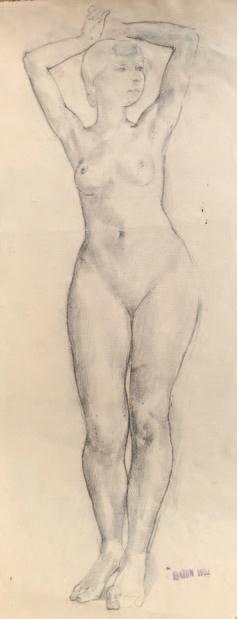
Standing Female Nude, 1932, pencil [cat. 03]
Photographs from Clark’s time in active service in Egypt at the end of World War Two

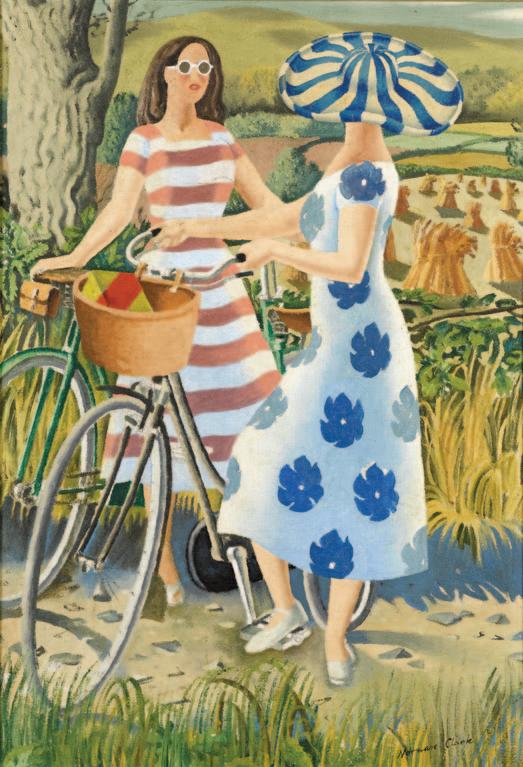

Clark left the RA Schools in 1935 ‘He has equipped himself with an understanding of drawing and painting,’ W.T. Monnington reported, ‘that should enable him to develop well as an artist now that his student days at the school are over, for he has shown that he has in him the making of an artist.’ But Clark had only a few years in which to find his path.
In 1939 another world war broke out. He served through
the course of it, first with the Royal Armoured Corps, then
with the Royal Engineers. ‘Apart from one year in Italy,’ he would write, ‘a somewhat unspectacular five and a half year service in the Army allowed me little opportunity for sustained painting, but I was at least able in private moments to sort out my ideas and to decide on a direction for the future (if there was to be one).’
Having married in 1940, the decision Clark made for the
future was a safe and conventional one: he would raise a
family, and he would teach. Having returned home from Egypt in 1946, by the following year he had found a position at Brighton College of Art. He quickly settled
down to a simple but comfortable life in the village of Hurstpierpoint, in East Sussex. It would be his home for the rest of his life. The pictures he painted there were those of a land at peace, and (mostly) at ease with itself. And why not? Ravilious had done much the same happily enough before the Second World War, though he had not been fortunate enough to survive it. Clark had survived. Live, love, look, paint, he may well be saying in his work. Done well, it’s a sound philosophy for life. It’s what makes the pictures so poignant, so touching, and so engaged in the moment ... catching it all before it passes.
David Boyd-Haycock
Early work
In 1929, aided by the Essex County Art Scholarship and following encouragement from his art master at
Bancroft’s School in Woodford, Norman Clark began his formal art training at Central School of Arts and
Crafts. Although staying for less than a year he benefitted from the teaching of a number of prominent young artists including William Roberts, Bernard Meninsky and John Farleigh. For financial reasons Clark moved
to the Royal Academy Schools in 1930. He was a star pupil winning the Edward Stott Scholarship, the
Landseer Prize for Mural D ecoration and in 1935
L
verhulme Scholarship. Thomas Monnington (later president of the Royal Academy) who taught him there described him as “certainly one of the most interesting students at the Royal Academy schools in the two years I have been teaching there”.
The influence of his teachers Meninsky a
Rob
rts
oms large in some of his earlier 1930s work as does
European art of the period. The British Illustrators he had admired in newspapers and magazines of his childhood, such as Punch and Illustrated London News also touch on the style of his drawings.


CAT. 1
The Vicar at Highbrook with Yo-Yo
Bears inscription, date and title (reverse of mount): The Vicar Highbrook, c.1931 with Yo-Yo Pen and black ink 13.5 by 15 cm (5 ½ by 6 ins)
CAT. 2
Whitestone with Gamekeeper Richardson, 1931
Inscribed with title and dated (to reverse of original mount)
Squared for transfer Pen and black ink, 11 by 13 cm (4 ¼ by 5 ins)
This sketch of Clark’s parents home, Whitestone in Highbrook, is one of several he painted of the house from above (an impossible viewpoint) showing his ability to capture by memory a place that he knew intimately.
Standing Female Nude
With date stamp: 4 June 1932
Pencil, 40 by 17 cm (15 ¾ by 6 ¾ ins)
The stamp on this drawing dates it to Clark’s third year
as a student at the Royal Academy Schools. Drawing
was a major part of the training there with Thomas
Monnington as drawing master during Clark’s time
Monnington had been a Rome Scholar in the previous
decade and had a background in extremely rigorous
draughtsmanship.


4
The
Visi
tation
Signed and dated l.l.: Norman Clark/1933
Oil on board, 60 by 39.5 cm (23 ½ by 15 ½ ins)
Clark’s work from his time at the Royal Academy Schools suggests a highly precocious student who had already developed a mature style as a painter. His first work had been accepted for exhibition at the Royal Academy Summer Exhibition in the same year as this painting (Reclining Woman, no 593) when he was only twenty.

Signed and dated l.r.: Norman Clark/1933
Oil on board laid to card, 35 by 45 5 cm (13 ¾ by 18 ins)

Still Life with Kitchen Sink, 1938
Signed and dated l.l.: Norman Clark/38 Oil on board, 38.5 by 27 5 cm (15 ¼ by 10 ¾ ins)
This early still life depicts the kitchen at Clark’s home, Whitestone in the Hamlet of Highbrook near East Grinstead.

Still Life with Potato and Pot
Oil on canvas, 20 by 25 5 cm (7 ¾ by 10 ins)
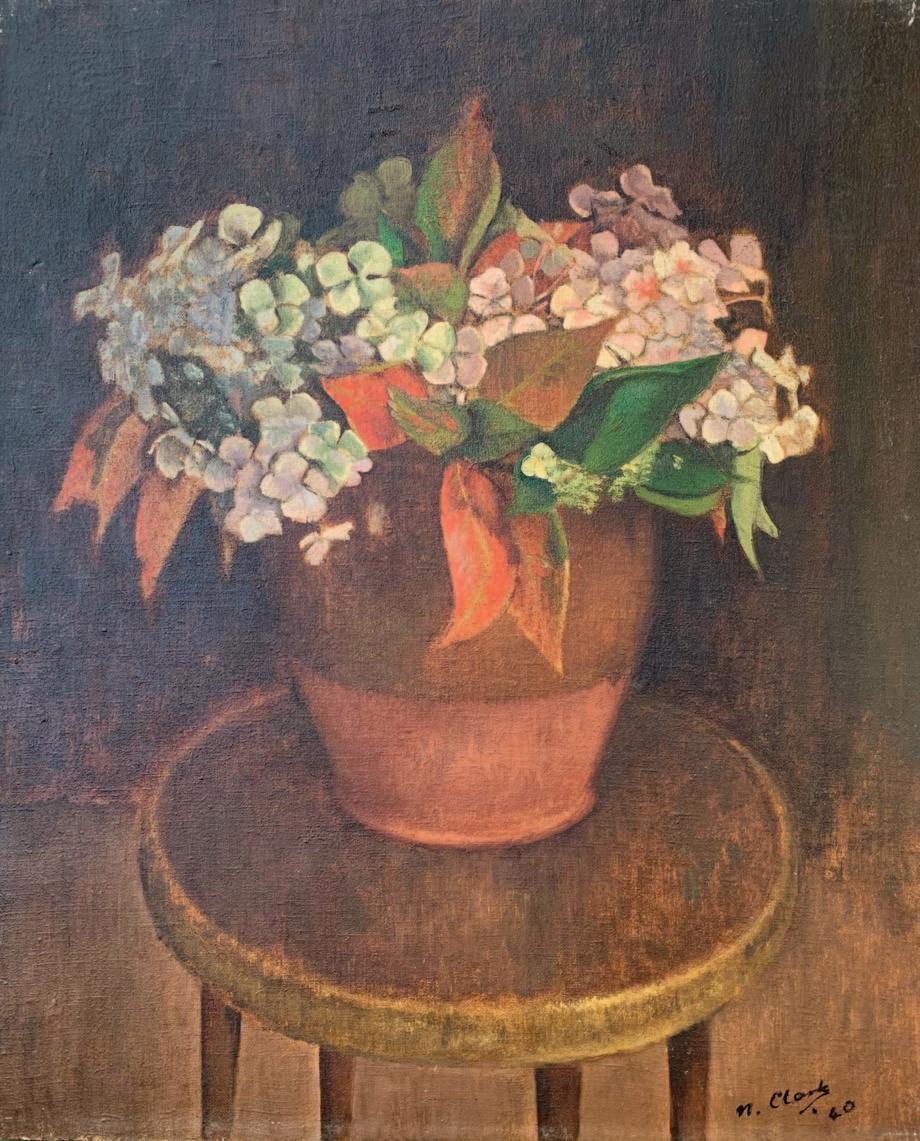
WarLike so many emerging artists of his generation, Clark’s career was interrupted by War and he was called up in 1940. After a time serving with the Royal Armoured Corps he was transferred to the Royal Engineers where his artistic skill was put to use in the task of drawing and copying maps. In 1944 his unit was called to the Allied Mediterranean Front in Southern Italy. Clark’s most significant Wartime output is a pictorial record of his unit’s time overseeing a part of Southern Italy near Naples. These pictures, subtle in subject but vibrant in palette, provide a record of the desolation and devastation following the Allied advance in the previous year, notable for their “use of colour, especially the explosive pinks, vivid orange or threatening midnight blue…capturing well the sadness as well as danger of the situation.” (Timothy Wilcox, pamphlet for Art at the Front, World War II Paintings and Drawings by George Hooper and Norman Clark, Hove Museum (Brighton Festival Exhibition), May-June 1995).
Following a year in Italy, Clark served for a period in the Middle East before returning to Sussex in 1946. Several works by Clark from his time in Italy and the Middle East are now in the collection of the Imperial War Museum.
CAT. 9
Night Embarkation, Liverpool, 1944
Inscribed with title on label affixed to blackboard
Wash over pen and black ink
15 by 23 cm (6 by 9 ins)
On loan from the artist’s daughter



CAT. 10
On the Troopship to the Central Mediterranean Force, 1944
Signed with initials l.r.: NC and inscribed verso with date, title and artist’s address
Pen and blue/black ink, 22.5 by 17 cm (9 by 6 ¾ ins)
CAT. 11
Under the Mosquito Net, Maddaloni, 1944
Inscribed and dated l.r.: The “Old Soldier” –under the mosquito net – Billets Maddaloni/ Dec 44
Pen and black ink, 23 by 17 cm (9 by 6 ¾ ins)
Clark’s unit took over a large house in Maddaloni, just in-land from Naples in the Winter of 1944 and “converted the cellar into the mess, painting bold half-timbering on the walls in an attempt at a recreation of rural England”. (Tim Wilcox, pamphlet for Art at the Front, World War II Paintings by George Hooper and Norman Clark, Hove Museum & Art Gallery, May-June 1995)

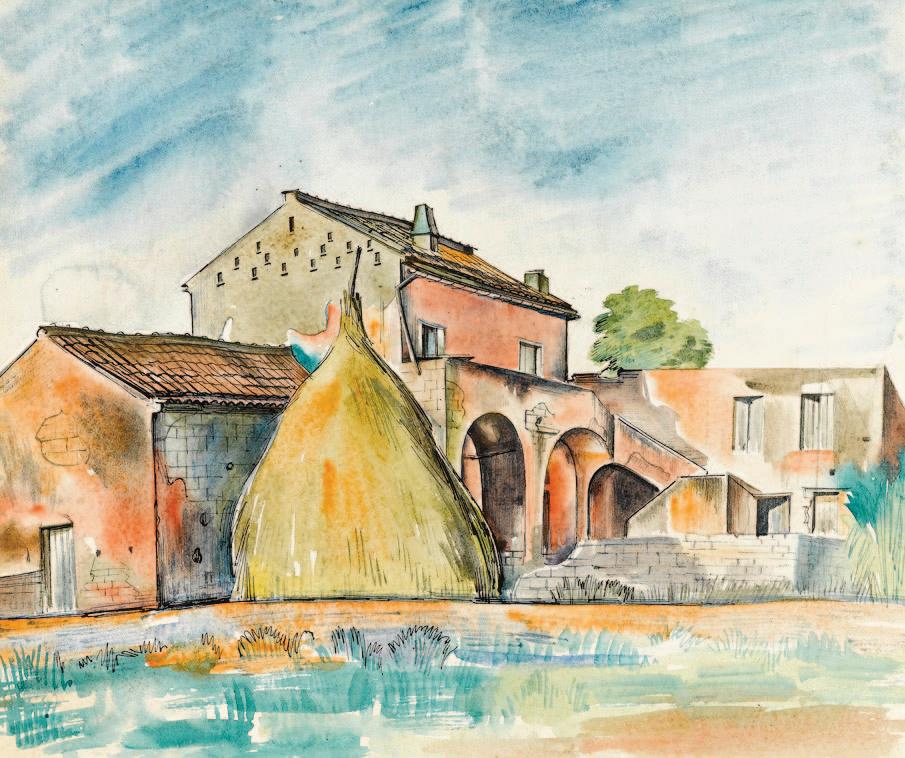
Deserted Farmhouse with Haystack, Southern Italy, 1944
Inscribed (verso) with title, date and artist’s address Watercolour over pen and ink, 31.5 by 37 cm (12 ¼ by 14 ½ ins)

14
ercolour over pen and brush and ink, 18.5 by 22.5 cm (7 ¼ by 9 ins)

Avenue of Trees Southern Italy, c.1944
gned l.l.: Norman Clark and inscribed Landscape Southern Italy Watercolour over pen and ink, 22.5 by 31.5 cm (8 ¾ by 12 ¼ ins)

Bombed and Deserted Farmyard, Southern Italy, 1944
Signed and dated l.l.: Norman Clark/1944 and inscribed l.l. Deserted Farm Buildings, Southern Italy Watercolour over pen and ink, 23.5 by 37 5 cm (9 ¼ by 14 ¾ ins)
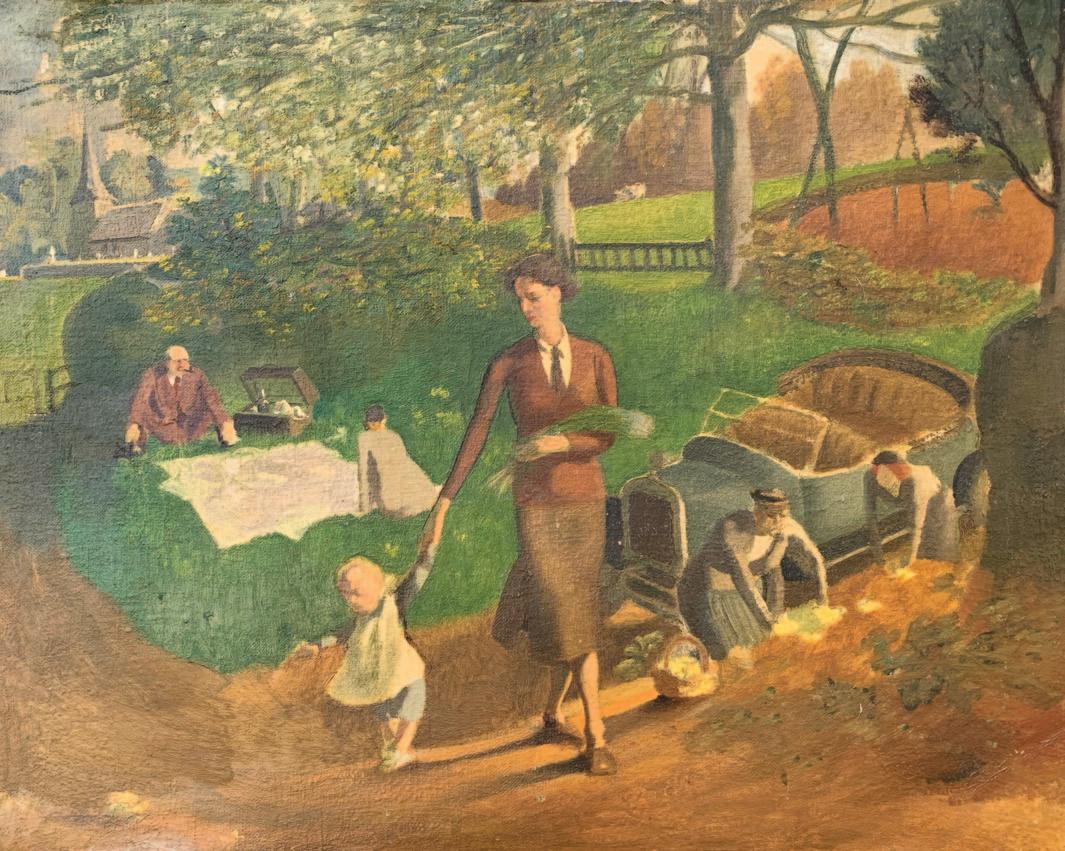
Oil on canvas, 40 by 50.5 cm (15 ¾ by 20 ins)
Soon after his return from active service, the Clark family bought a house in 1948 in Amwell Place in the heart of the Sussex village of Hurstpierpoint. He remained in the village for the rest of his life initially only moving across the street to a new house, Applegarth, before buying Mountfield in 1969, a house that opened out directly on to the South Downs. The rooms, gardens, garages and windows of his three houses here provided the primary inspiration for much of his later work as well as the lens through which he viewed Hurstpierpoint village life. He rarely relied on the conventional for his subject matter, choosing instead unusual and oblique viewpoints through windows, along rooftops and gulleys and finding beauty in the mundane, whether radiators, soft furnishings, taps, colanders or curtains. He also settled into working life joining the staff of Brighton School of Art in 1947 and later becoming a senior lecturer in art at Brighton Polytechnic in 1966. He was elected an associate of the Royal Watercolour Society in 1953, becoming a full member in 1960. This society (alongside the Sussex Painters and Sussex Watercolour Society of both of which he was a leading member) w
primary
t for showing his work as a professional painter.
18
Portrait of a Boy in a Red Jumper
Signed and dated l.r.: Norman Clark/52
With a view through a window at Amwell Place (reverse of canvas)
Oil on canvas, 49.5 by 40.5 cm (19 ½ by 16 ins)
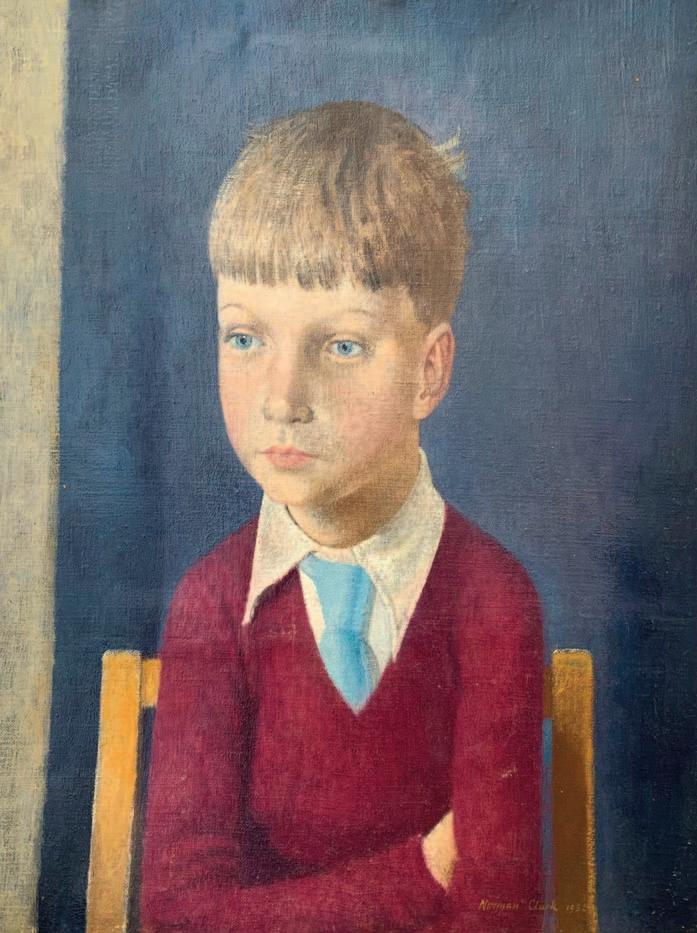

Still Life with a Copy of the Listener
Signed l.l.: Norman Clark and further signed and dated (to reverse of canvas): Norman
Clark/1949 and inscribed 1 Amwell Place, Hurstpierpoint, Sussex/Title: - Attic Window No.1 Oil on canvas, 51 by 61 cm (20 by 24 ins)

20
Rooftops and Drain Pipe, Hurstpierpoint
Signed and dated l.r.: Norman Clark/54
Oil on board, 61 by 50.5 cm (24 by 20 ins)
This is painted from the back of the house at Amwell Place looking across the roofline from the artist’s daughter’s bedroom. She recalls how owls would hoot on the chimney stacks at night.
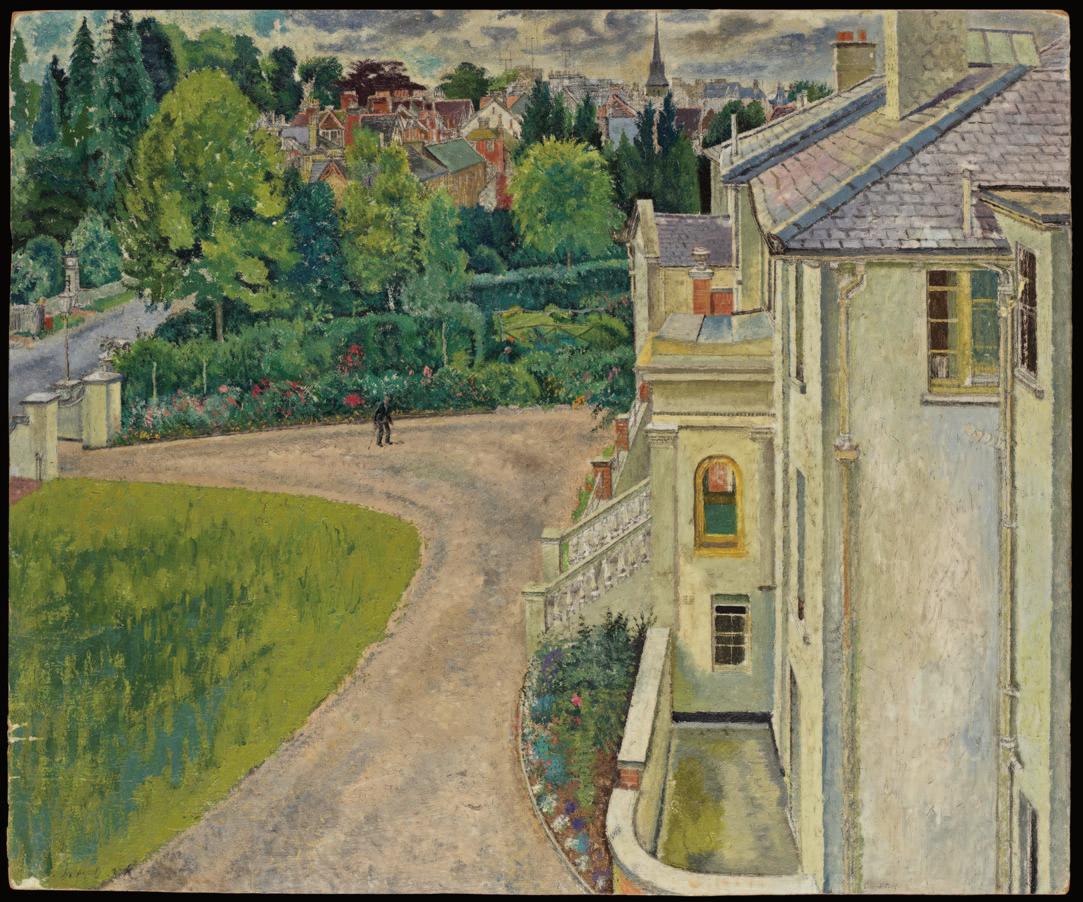
The Village of Hurstpierpoint from the Attic Window at Amwell Place, c.1949
Signed and with the artist’s address and title (to reverse of board) Oil on board, 51 by 61 cm (20 by 24 ins)

Gathering Wood in Winter, Hurstpierpoint
Signed l.l.: Norman Clark
Watercolour over ink
Exhibited: London, Royal Watercolour Society, 1963, as “Apple Garden, Winter”; possibly, London, Royal Academy, 1964, no.627
This winter scene is taken from the Clark’s second house in Hurstpierpoint, Applegarth. Like many of his landscape watercolours, the figure gathering wood is probably taken from his imagination. As Clark painted similar subjects on numerous occasions, the absence of labels can make it difficult to identify his exhibition pieces. The present work was exhibited at the Royal Watercolour Society and possibly under a very similar title at the Royal Academy in 1963.
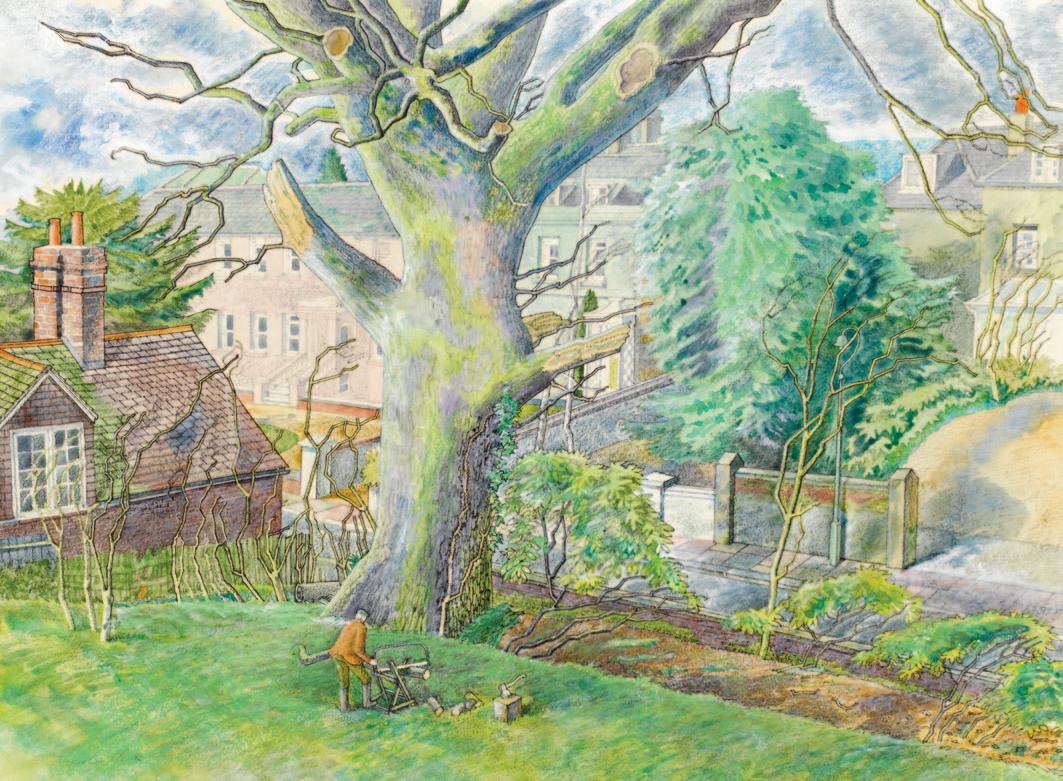
The Oak Tree at Applegarth
Signed l.l.: Norman Clark
Watercolour over pen and ink, 34.5 by 47 cm
Exhibited: possibly, London, Royal Academy, 1963, no.865
The work depicts the same garden as cat. 24, at Applegarth where the Clarks had moved in 1960. Their previous house, 4 Amwell Place, is visible across the street.
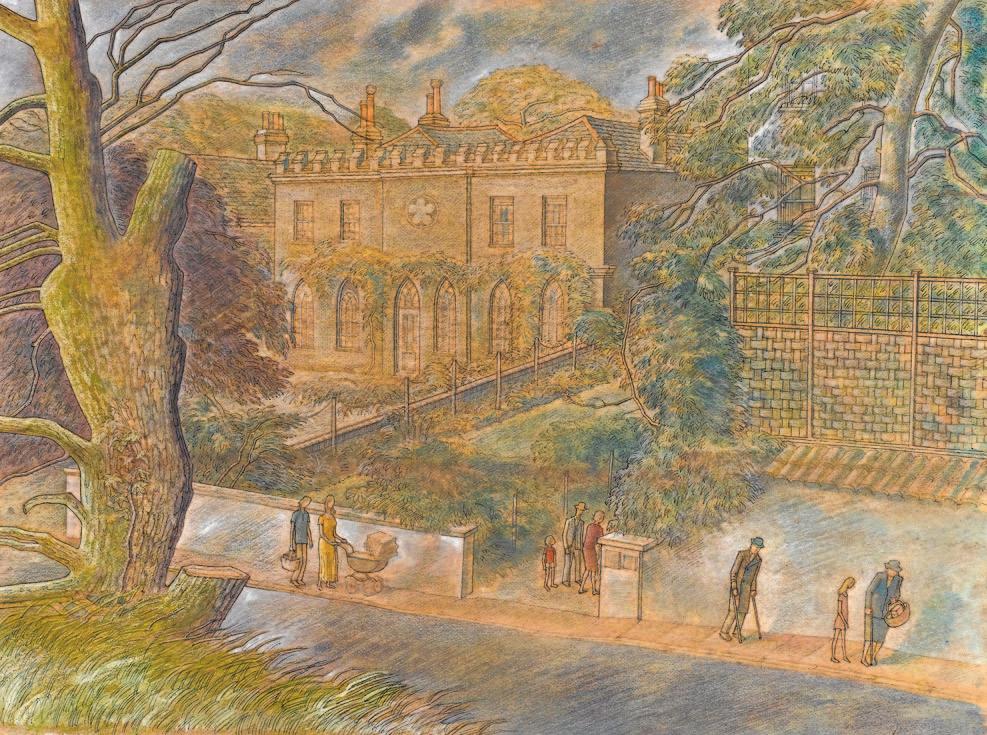
24
The Gothic House, Hurstpierpoint
Watercolour over pen and ink, 36 by 47 cm (14 by 18 ½ ins)
The prominent Gothic House was opposite Clark’s house, Applegarth. The artist’s daughter Penny briefly lived in a flat in the building from which the artist later painted a view of the back garden and garage (cat.23).

Studio Interior, 1961
Signed l.l.: Norman Clark and inscribed with title (verso)
Watercolour over pen and ink, 37 by 45 5 cm (14 ½ by 18 ins)
Studio still lifes were a favourite subject of Clark’s in all three of his Hurstpierpoint houses. The present more modern interior of Applegarth contrasts with the Victorian Mountfield with its rigid sash windows (see cat.29). Both works make use of the window (a favourite device of the artist’s) to frame a further scene beyond the principal composition.
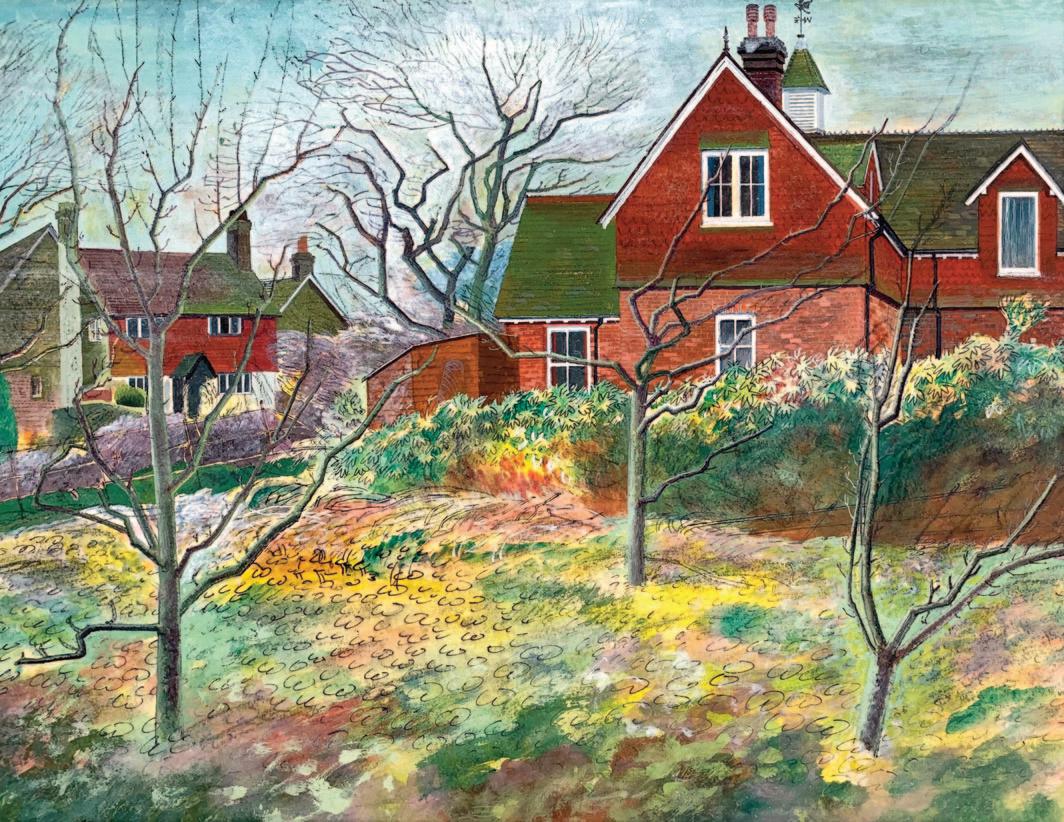
The Front Garden, Applegarth, Hurstpierpoint, Sussex
Signed and dated l.l.: Norman Clark/61
Watercolour with gouache over pen and ink, 34.5 by 44.5 cm (13 ½ by 17 ½ ins)

Still Life with a Paint Box and Pipe
Signed and dated l.r.: Norman Clark/69 and further inscribed with the artist’s address and picture title (to reverse of board)
Oil on canvas laid to board, 51 by 61 cm (20 by 24 ins)
Later work (1970 - 1992)
Clark’s work arguably reached its technical heights in the final decades of his life. Still largely focusing on the architecture and surroundings of his final Hurstpierpoint home, Mountfield, the paintings from this period are frequently more ambitious in scale and conception, displaying a striking mastery of perspective and complex composition. Such works are all the more impressive for their combination of closely observed detail and imagery from the artist’s own fertile imagination – evident in his ability to paint a subject from an impossible viewpoint high above (as in cat 02.) or to invent a scene from scratch employing motifs from everyday life (such as the Nash-like The Log Store, cat.36.). Retirement from teaching in 1978 allowed him to dedicate himself more fully to painting, the artist’s family remembering him hardly ever being without a pencil or sketch pad in his later years.
28
A Room with a View,
Mountfield
gned and dated l.r.: Norman Clark/78 (?) and inscribed with title (verso) Watercolour over ink heightened with chalk, 48.5 by 62.5 cm (19 by 24 ½ ins)


View from the Bedroom Window, Mountfield
Signed: Norman Clark Watercolour over pen and ink, 25 by 34.5 cm Exhibited: London, Royal Academy Summer Exhibition, 1969, no.231

30
Walking Dogs on the South Downs
Signed and dated l.l.: Norman Clark/73 Watercolour over pen and ink heightened with white chalk, 52 by 66.5 cm (20 by 26 ¼ ins)
This view of the spectacular downs landscape from the back of Mountfield is painted from a higher viewpoint than would have been possible from the building itself. Such paintings are evidence of Clark’s extraordinary and photographic memory for detail and composition.

The Studio, Mountfield
Signed and dated l.l.: Norman Clark
Watercolour over pen and ink, 69 by 52 cm (27 ¼ by 20 ½ ins)
The work on the easel here appears to be an oil version of the painting from the upper window of
Gothic House in this catalogue (cat.32).
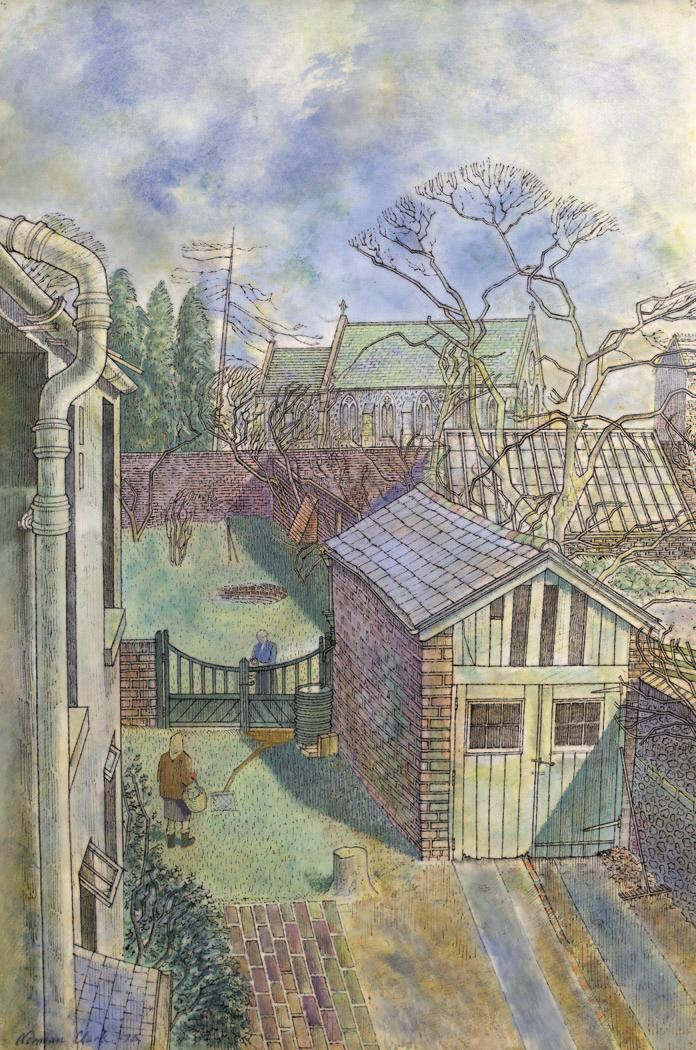
32
The Garage, Gothic House Looking towards St George’s Church
Signed and dated l.l.: Norman Clark Watercolour over pen and ink with chalk, 59 by 39 cm (23 ¼ by 15 ¼ ins)
This was painted from the flat briefly occupied by the artist’s daughter in Gothic House (see also cat.31).
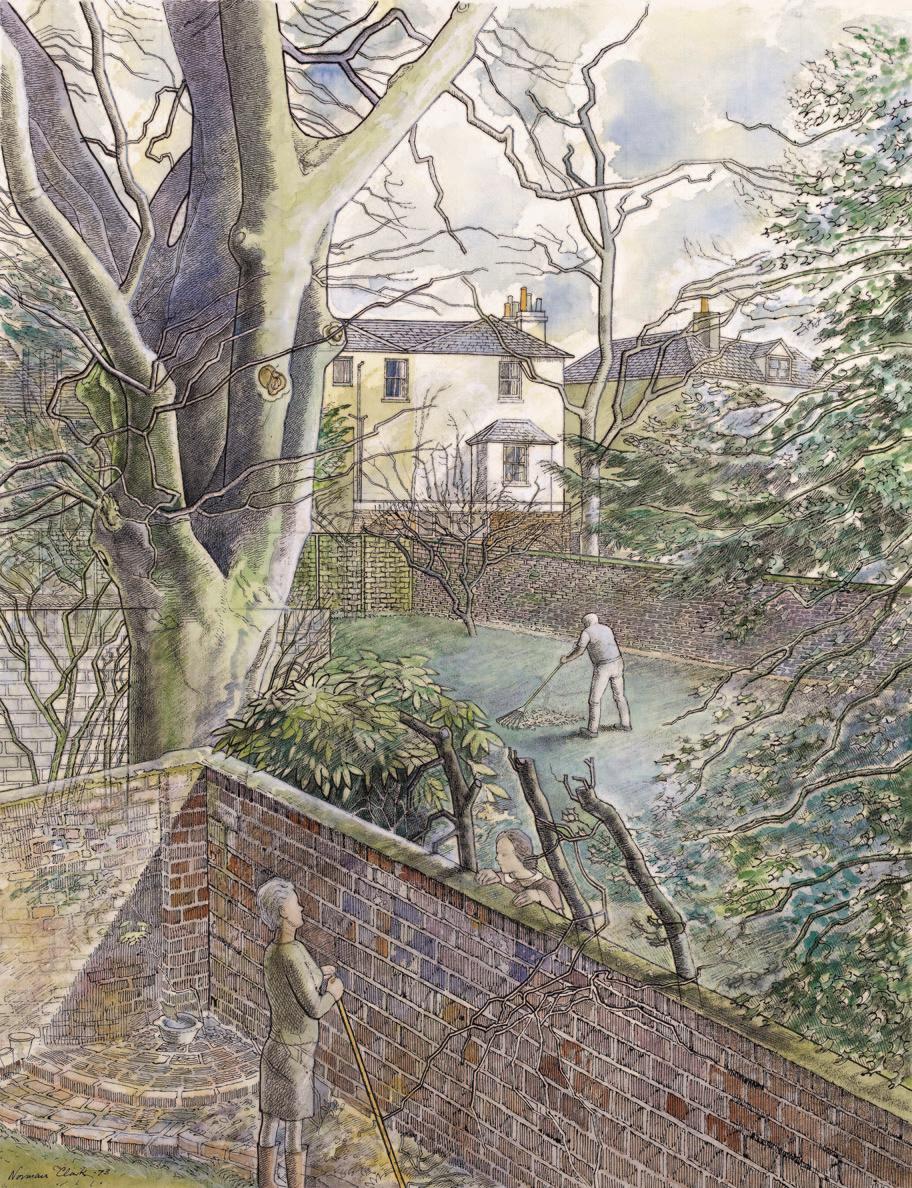
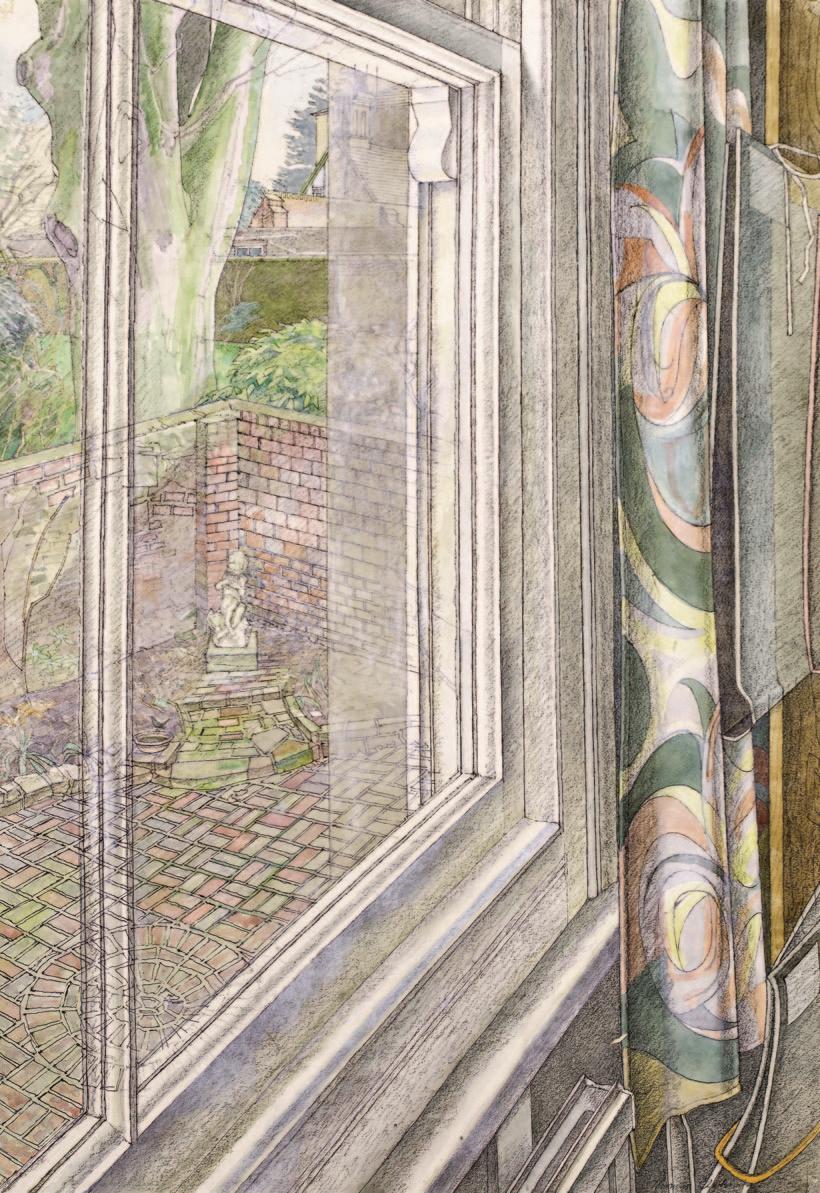
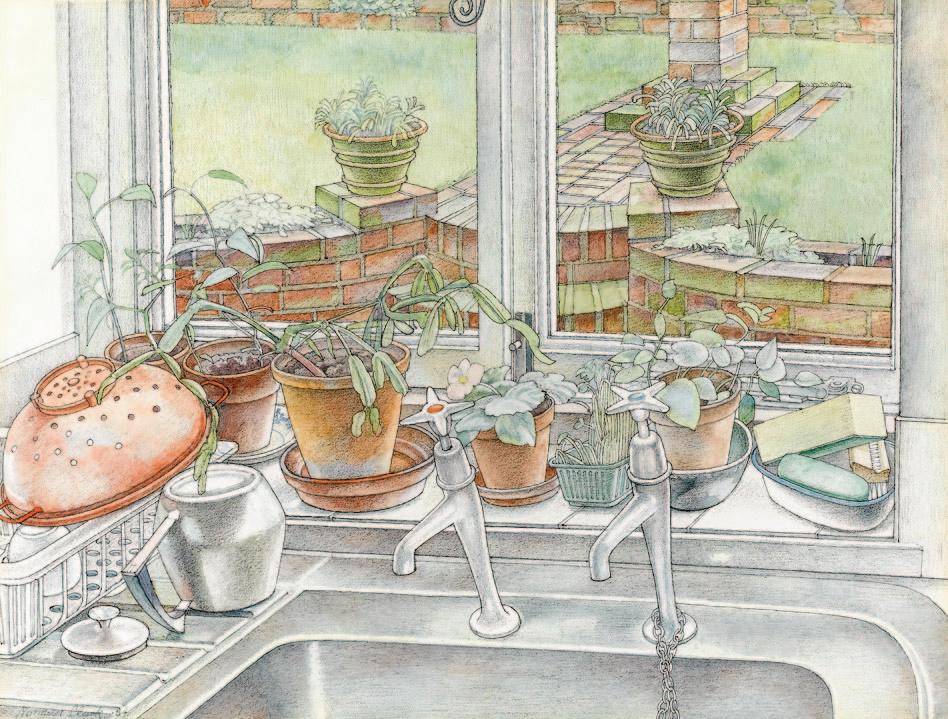
Kitchen Sink Still Life
Signed l.l.: Norman Clark/84
Watercolour over pen and ink, 34 by 44.5 cm (13 ¼ by 17 ½ ins)
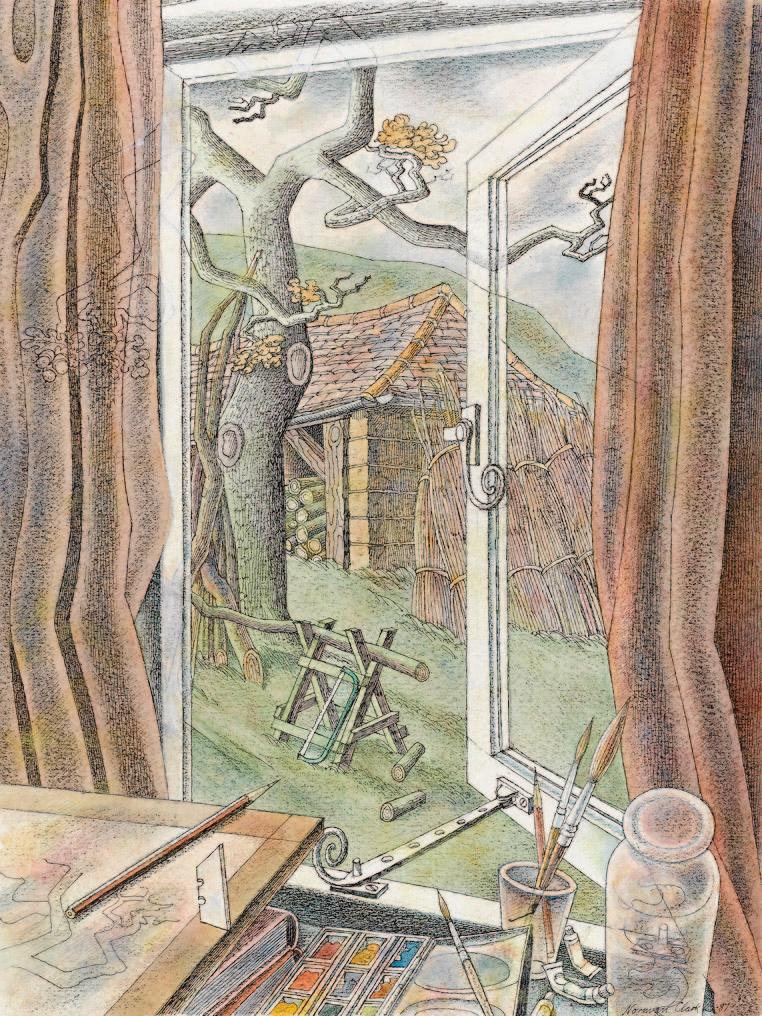
36
The Log Store
Signed and dated l.r.: Norman Clark/87
Watercolour over pen and ink with chalk, 41 by 30.5 cm (16 by 24 ins)
The artist’s daughter believes the present work was painted entirely from Clark’s imagination, employing the same elements of English architecture and landscape apparent in so many of his works. The log motif is, in particular, a tribute to the English painter Paul Nash whose work Clark had admired ever since he was a student.
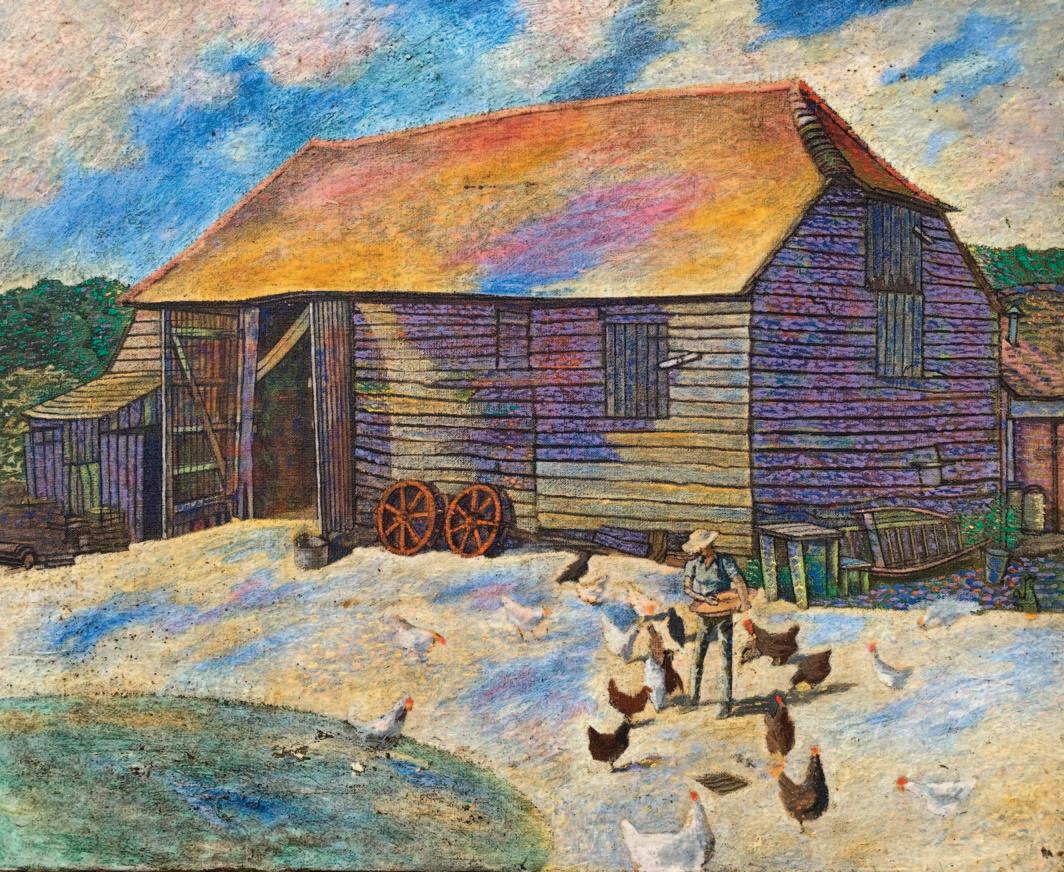
The Barn, Tott Farm, Hurstpierpoint
Oil on canvas, 50.5 by 61 cm
Exhibited: possibly London, Royal Academy, 1960, no.988
“Much of my work has been concerned with the human figure. Whenever … I draw from memory it is always a human being that appears. Characters from the past seem to pose for me in my mind, some of them being deceased relatives, some never seen before.” Norman Clark writing in 1989
Figure subjects were the most commercially successful of Clark’s paintings from the
Post War period and he submitted (and sold) many at the annual Royal Watercolour
Society exhibitions in London. Figures appear in many of his works and often populate his larger landscape and architectural paintings. Most were painted from his imagination and certain figure types are regular motifs in his fine compositional groups (amongst them families with young children, neatly dressed walkers and clergymen). Although his palette grew slightly fainter in older age, he painted some of his finest examples of these subject pictures (such as The Squeeze from 1991, cat.46) towards the very end of his life
CAT. 38
Spring Ramble, 1958
Signed and dated l.r.: Norman Clark/58
Watercolour, 31 by 48 cm (12 ¼ by 19 ins)
Exhibited: London, Royal Watercolour
Society, 1958

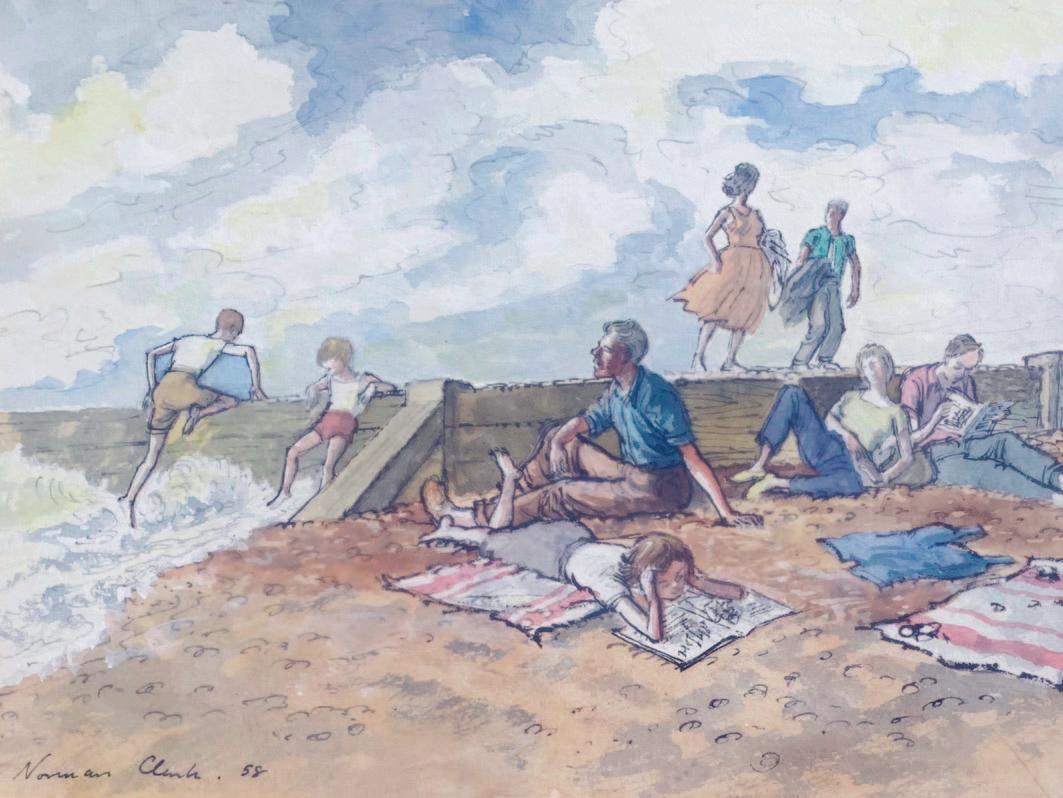
On Brighton Beach, 1958
Signed and dated l.l.: Norman Clark/58
Watercolour over ink, 23 by 12 cm (9 by 12 ins)
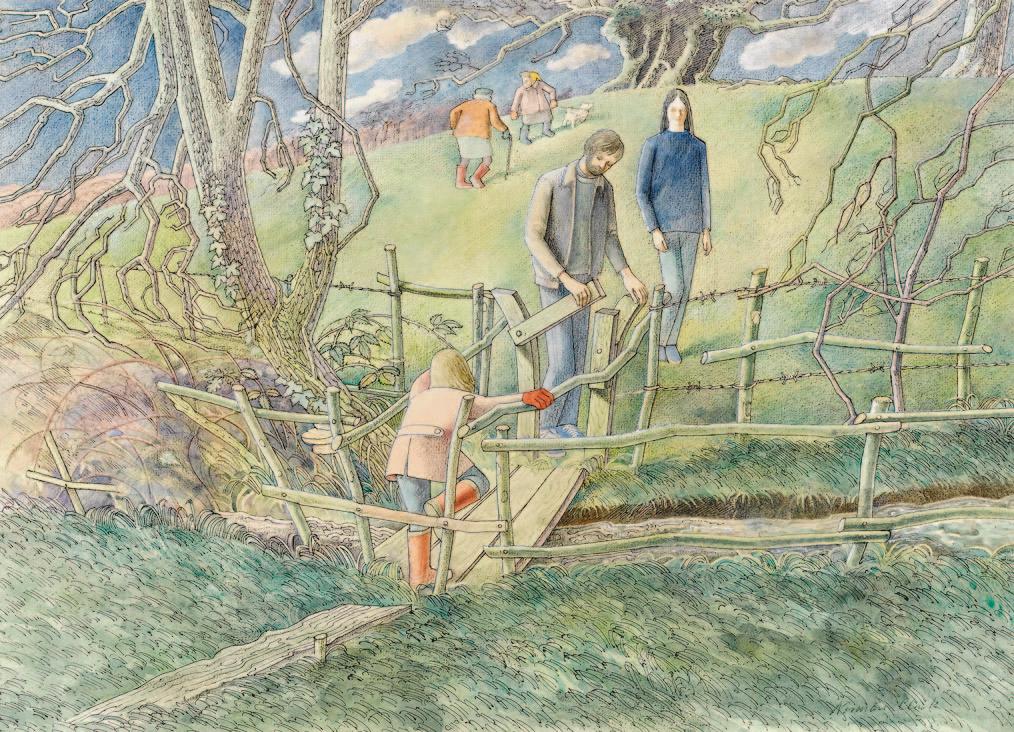
The Little Bridge
Signed l.r.: Norman Clark and inscribed with title (verso)
Watercolour over pen and ink, 32 by 43 cm (12 ½ by 16 ¾ ins)
The present watercolour is relatively rare in being a figure subject depicting people directly from real life, in this case the artist’s daughter and her family on a walk in the Sussex countryside

The Family Walk
Signed and dated l.r.: Norman Clark/86
Watercolour, 18 by 23.5 cm (7 by 9 ¼ ins)

Signed and dated l.r.: Norman Clark/86
Watercolour, 18 by 23.5 cm (7 by 9 ¼ ins)

The Narrow Pavement
Signed and dated l.r.: Norman Clark/88
Watercolour over chalk and ink, 17 5 by 22.5 cm (6 ¾ by 8 ¾ ins)
Exhibited: London, Royal Watercolour Society, 1988, no.4

The Quarrel
Signed and dated l.r.: Norman Clark/87
Watercolour over chalk and ink, 22 by 33 cm (8 ½ by 13 ins)
Exhibited: London, Royal Watercolour Society, 1987, no.1

l on canvas, 35 by 46 cm (13 ¾ by 18

Signed and dated l.r.: Norman Clark/91
Watercolour over pen and ink with pencil, 34.5 by 46 cm (13 ½ by 18 ins)

The Little Library
Signed and dated l.r.: Norman Clark/92
Watercolour over soft pencil, 18 by 23.5 cm
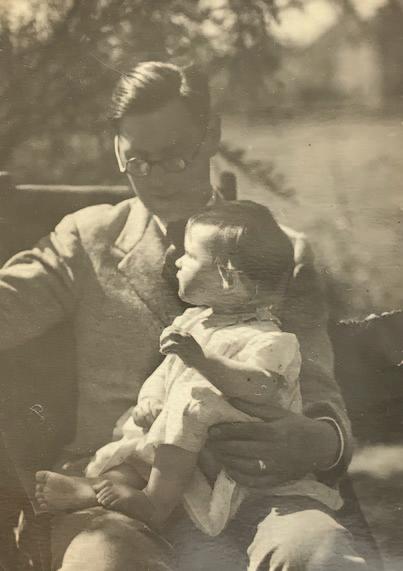
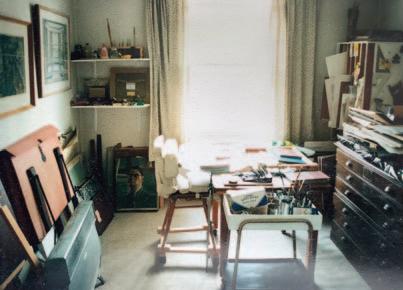

NORMAN CLARK, RWS (1913-1992)
A CHRONOLOGY
1913 Born 17th February Ilford, Essex
1929-30 Studies at Central School of Art, London
1930-35 Studies at Royal Academy Schools, London
1931 the Edward Stott Prize in Historical Painting
1932 Landseer Prize
1933 Exhibits for the first time at the Royal Academy
1935 Gold Medal for Painting and the Leverhulme Scholarship
1940 Marries Constance Barnard
1944 Posted to Southern Italy with the Royal Engineers
1946 Posted to the Middle East and Egypt
1947 Moves to Hurstpierpoint in Sussex; teaches at Brighton
College of Art
1953 Elected an Associate of the Royal Watercolour Society
1960 Elected a member of the Royal Watercolour Society
1966-78 Senior lecturer at Brighton Polytechnic
1992 Dies 19th June, Hurstpierpoint
1995 Art at the Front – World War II Paintings by George Hooper and Norman Clark, Hove Museum and Art Gallery (May-June)
PUBLIC COLLECTIONS
The Royal Collection
The Royal Watercolour Society Collection
Imperial War Museum, London
Harris Museum and Art Gallery, Preston
Brighton and Hove Museums
Sherborne Museum


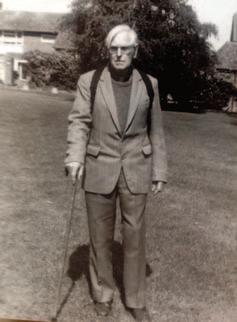
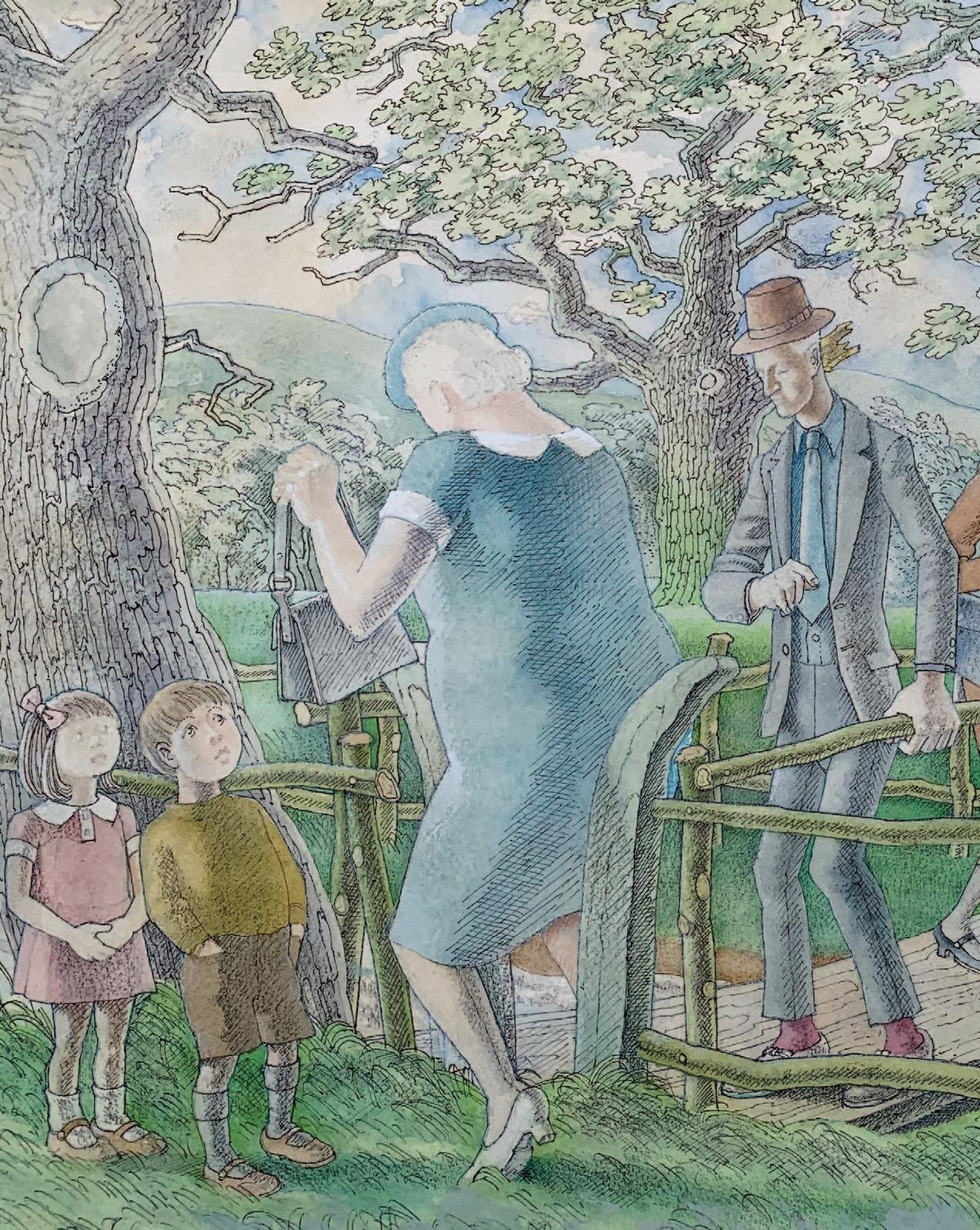

HARRY MOORE-GWYN BRITISH ART

